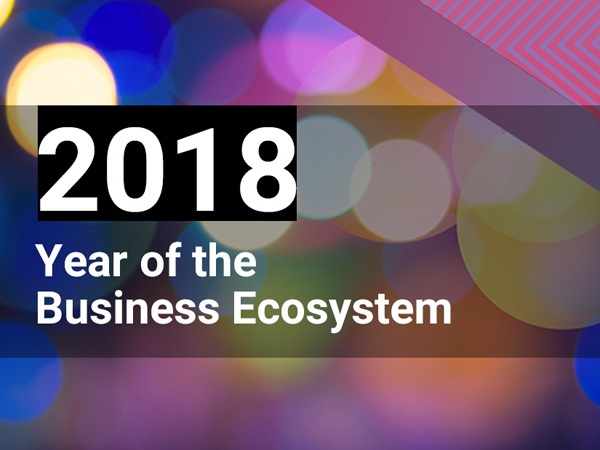End of Year: From Logical Design Solutions: 10 Trends that dominated the enterprise digital landscape
For our end-of-year articles, we are presenting some of the most interesting blog posts created by our friends in the NJ t
This year marks the eighth year of digital transformation and of the Fourth Industrial Revolution (4IR). Even eight years on, the revolution is in its early days; businesses and people are yet to experience its full impact. But over the past twelve months, business leaders found real footing in the pursuit of flexible, networked ecosystemstrategies. Long-standing vertical business models (organized by supply and demand for goods and services) began to give way to open, cross-industry ecosystems. These ecosystems, powered by digital platforms, mobilized demand-side economies. Meanwhile, digital technologies like robotics and AI matured and gained meaningful traction in 2018. In combination, these developments create the underpinnings of new, integrated digital enterprises.
Our Year in Review explores the challenges and opportunities of emerging business ecosystems. Read on for what we collectively learned this year and to find out how these insights inform new priorities for digital leadership.
- Digital Pace in a Nonlinear Race
Business leaders know that digital has accelerated the rate of change in business globally. Business practices and digital roadmaps, however, don’t yet reflect the exponential, nonlinear pace of digital.
What moved?
Business leaders acknowledged the need to think differently and innovate faster. Pilots were launched. Other models of digital acceleration emerged. Areas like talent acquisition and call center management became low-hanging fruit for automating repetitive processes. With the promise (and threat) of AI, big data and analytics moved to center stage, fueled by aggressive funding. Ultimately, digital strategies and roadmaps found value in an environment of digital enablers.
What didn’t move?
Although businesses aspire to the pace of digital, they are still operating and making decisions in conventional ways. Automation, for example, often fixed already-broken processes. Big data set aggressive data collection agendas but often with unclear purpose or unattainable schedules. Adopting digital ways of working is a wholesale change – it means thinking and operating in nimble digital contexts, with crisp, iterative approaches and the means to sense digital risk and quickly adjust. This know-how requires enabling technology in the hands of savvy digital leaders whose judgment and ingenuity will usher in the new era of value creation.
- Big Data Warms in Context
Machines have conquered big data, but humans need to warm that data with interrelated contexts if they’re going to address unmet (even unspoken) needs.
What moved?
Concerns about big data have shifted. It’s not about whether data is unstructured or structured; it’s about whether data insights are appropriately contextualized to make them actionable. Business leaders recognized that their big data investments must go beyond the science of data and the art of visualizing it. The acknowledged risk is that when complexities of situational interdependencies are disregarded, even the most easily consumable, analytically sound outputs may leave business consumers out in the cold.
What didn’t move?
Businesses are still experiencing the double-edged sword of big data. While big data affords more efficient statistical learning, it also compounds our problems when algorithmic decisions get made in isolation from broader, complex, and human contexts. Organizations should add human-based quantitative methods, such as warm data, to uncover opportunities to add new value.
3. Ubiquitous AI Lacks Purpose
On-device AI
revolutionizes how we connect, how we compute, and how pervasively we
experience digitally intelligent interactions. It’s time to find better ways to
use this technology to benefit not only our customers, but also our workers.
What moved?
The big shift from cloud-based machine learning to on-device AI implies that intelligent support can now be everywhere and always on. This shift has inspired an explosion of digital tools, libraries, and cloud-enabled services for simplifying AI solution creation, management, and deployment. In the consumer space, these capabilities power just-in-time decision making and higher-level strategic value propositions.
What
didn’t move?
Business strategy around intelligent technologies remains widely customer-focused. Meanwhile, inside the enterprise, AI remains a missed opportunity. It holds the promise of helping people work smarter and more efficiently – but businesses must invest in enterprise digital strategies that will make these intelligent interactions relevant, useful, and essential to workers in the contexts of their jobs.
4. Platforms Mobilize Underutilized Assets
Previously disrupted legacy organizations gain momentum as they enter platform-powered ecosystems. These organizations can tap into underleveraged resources – resources many tech disruptors don’t have – to unlock assets in new exchanges and relationships.
What moved?
Large-scale participation on business platforms confirmed our prediction from last year, but we saw surprising movement from legacy organizations. They had more to offer (and more to gain) than disruptors because of robust, established sets of assets, experience, and people. For these organizations, value accrued from key learnings and insights that emerged from interactions with previously dormant resources.
What didn’t move?
Legacy businesses are still not fully leveraging their assets. They should move aggressively to expand their platforms across emerging ecosystems – particularly to new or underserved constituents in new or long-tail markets.
5. Digital Leadership at 10%
Even though leaders universally recognize growth of profit, revenue, and operational efficiency as goals of digital transformation, only a fraction of them successfully inspire cross-functional alignment to key initiatives.
What Moved?
Digital leaders armed themselves with strategy and commitment to operational transformation. They fostered situational, competency-based, collaborative, and autonomous ways of working. Results speak for themselves: companies with effective digital leadership experienced 50% revenue gain and cost reduction over companies that still employ isolated, departmental solutions.
What Didn’t Move?
The cohort of successful digital leaders is still small: studies show that only 10% of companies have mastered the strategic, operational, and cultural changes needed for success. What differentiates leaders from novices, followers – even innovators – is an ability to align digital strategy and capabilities across the otherwise siloed structures in the organization. Meeting this challenge and sustaining the resulting momentum is critical to a leader’s task of bridging divides.
6. Organizational Change Needs Strategic Governance
Businesses continue to invest in digital solutions without funding the systems and structures that will support new mindsets and behaviors.
What moved?
Business leaders have let go of false hopes that new digital tools equal new organizational capabilities. Digital-first culture and mindsets are commonly cited as a business goal and factored into strategic messaging. Human capital systems designed to support these new behaviors are positioned as reflections of the employee value proposition and recognized as bellwethers of employer innovation and acumen.
What didn’t move?
Siloed vertical initiatives continue to dominate, despite the value placed on cultural outcomes. Leadership needs to align these disparate but organizationally related initiatives horizontally – maximum impact relies on cross-functional coordination. Strategic governance provides the means to systematically control and manage these digitally common initiatives, propelling organizational growth faster and moving the digital agenda with certainty.
7. Innovation Finds Traction in Iterative Waves
Movements in attempted “big bang” innovation have given way to practical, more effective innovation in waves of bite-sized, systematic explorations. These waves create the structure that innovation needs to become a digital-first organizational capability.
What moved?
Assumptions that innovation lives in unstructured spontaneity are weakening. Leaders realized this year that one-off events like hackathons don’t effectively foster workable ideas. Innovation is beginning to be planned, structured, and systematically promoted within the organization. Sustainable and actionable innovation is beginning to secure organizational alignment.
What didn’t move?
Companies struggle to incorporate these waves of innovation into their existing operating models in a reliable manner. While some businesses cultivate disruptive innovation at the edges of the organization, those practices aren’t yet fundamental to the organization at its core. To realize the new value that innovation promises, businesses need to embrace planning, executive sponsorship, and continuous learning.
8. Experiences Live in the Business Ecosystem
Platform-fueled businesses must consider the new business ecosystem as a living ecology – and the experience as the means for the ecosystem’s organic development.
What moved?
Pioneers in platform design shaped the conversation. They defined new infrastructures’ dimensions in tangible ways, provided transformation frameworks, and educated people about an economic phenomenon that’s still not widely understood. Meanwhile, early movers took advantage of existing infrastructures and aggregated platforms. Consequently, digital connections among ecosystem members activated new, bidirectional value creation.
What didn’t move?
Businesses continue to function without considering the living nature of these complex systems. They neglect the role of the experience as a critical precondition for people’s participation and a guarantor of ecosystem vitality. The experience supports the evolution of these organic systems as people interact and relate across multiple contexts. It’s time we recognize that user experiences monetize the ecosystem and ensure value is realized.
9. Voice Humanizes Digital
Consumers are embracing smart speakers and other voice-driven interfaces in increasing numbers, paving the way for voice-driven experiences in the workplace that enable more engaging and intuitive interactions.
What moved?
Consumers now enjoy the convenience of using their voices for daily tasks, such as finding information, scheduling appointments, and purchasing goods and services. Voice has seen success this year because digital capabilities have evolved to connect more effectively with the instinct for speech. Sensing this momentum, forward-looking organizations are looking for ways to incorporate voice-driven experiences into the workplace.
What didn’t move?
Businesses need to optimize conversational experiences that emphasize clarity and brevity without visual cues, context clues, or other nonverbal communications. To bridge this gap, voice-driven interfaces still rely on explicit confirmations to verify user intents. Until we reach a point where we can enable our systems to recognize our conversational idiosyncrasies, voice interfaces will see limited utilization.
10. Reskilling Workers, Just in Time
Millions of jobs are being disrupted. Minimally, workers need reskilling ahead of this curve. Ideally, businesses begin to shift focus from jobs as we’ve known them to the nature of new work.
What Moved?
For many skilled workers, the nature of work is fundamentally changing. Technology is replacing or augmenting whole classes of jobs. Cognizant of the shift, workers are now motivated to partner with technology. Rather than finding a technically savvy workforce elsewhere, employers are rightfully convinced that they must invest in their existing workforce to prepare them for changing work.
What Didn’t Move?
Employers still regard reskilling as an end state. But for resilient organizations, continuous development is the new normal. Workers need to be motivated and accountable to meet this challenge. They also need opportunities to retool in real time, seamlessly and as part of their jobs, through smart digital experiences.
Conclusion
These 10 trends have changed how work is planned, managed, executed, and measured in fundamental ways – and their impact will continue to reverberate. As we reflect on the impact of platform-powered business ecosystems, we move forward with several key takeaways:
- An exponential digital pace dominates successful business in the 4IR, with new ways of working that evolve people at the heart of organizations.
- Human-centered business contexts and experiences need to lift our newest digital capabilities for these business ecosystems to evolve.
- Increasingly, legacy organizations are keeping up with digital’s pace as they more effectively leverage their assets, people, and infrastructures.
- Sustainable momentum requires strong leadership, systematic innovation, and cross-functional strategic governance as the means for strategic alignment.
With 2018 behind us and with future-leaning perspectives, we have a vision of what’s to come in 2019.
Logical Design Solutions (LDS) is a digital strategy and design consultancy for the enterprise.For over 25 years, LDS has helped market leaders realize their most important business and people strategies through technological innovation. LDS’ expertise is inside the enterprise with the purpose to help large organizations operationalize their digital transformations for every employee.




